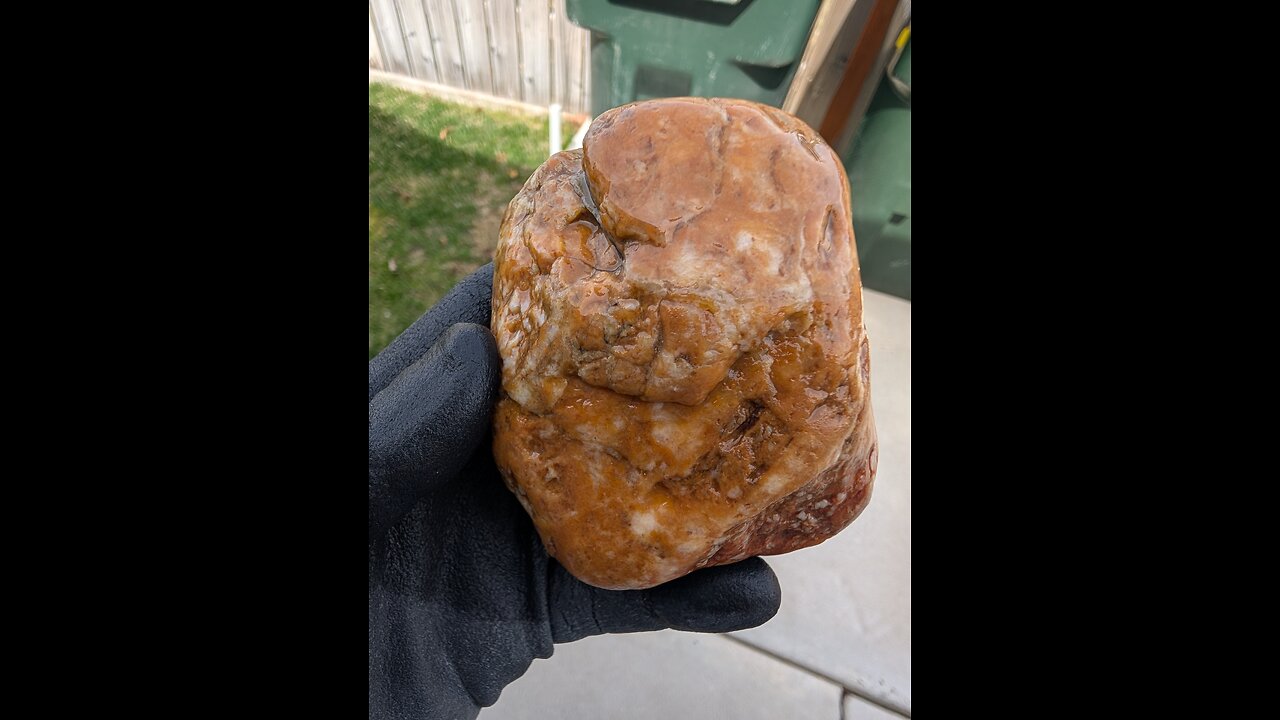Premium Only Content

The rock in the image appears to be a type of agate, likely a variety known as carnelian agate or a similar chalcedony-based stone. Here's why:
Color and Appearance: The rock has a translucent to semi-translucent quality with a mix of warm orange, brown, and white hues. Carnelian, a type of chalcedony, often exhibits these colors, ranging from pale orange to deep reddish-brown. The white patches could be due to inclusions or banding, which is common in agates.
Texture and Luster: It looks smooth and has a waxy to glassy luster, typical of chalcedony minerals like agate. The surface appears polished, either naturally or by human intervention, which is common for agates used in jewelry or collections.
Banding: Agates often have concentric banding or layering, and while the banding isn’t extremely pronounced in this specimen, the variations in color suggest some layering, which is a hallmark of agate formation.
What is Agate/Chalcedony?
Agate is a variety of chalcedony, which itself is a microcrystalline form of quartz (SiO₂). It forms in volcanic or sedimentary environments, often in cavities or voids where silica-rich fluids deposit layers over time, creating the characteristic banding. Carnelian specifically is valued for its warm tones and is often associated with iron oxide impurities that give it the orange-to-red coloration.
Other Possibilities
While carnelian agate is a strong candidate, there are a couple of other possibilities:
Jasper: Jasper is another form of chalcedony but is typically more opaque and lacks the translucency seen here. However, some jasper varieties can have similar colors.
Marble or Calcite: Some types of marble or calcite can have a similar appearance, especially with orange and white coloring, but they usually lack the waxy luster and translucency of chalcedony. Calcite also tends to be softer (Mohs hardness of 3) compared to chalcedony (Mohs hardness of 6.5–7).
How to Confirm
To be more certain, you could:
Hardness Test: Chalcedony has a Mohs hardness of 6.5–7, so it should scratch glass but not be scratched by a steel knife.
Translucency Test: Hold it up to a light source. Agates often show some translucency, especially in thinner sections.
Streak Test: Chalcedony typically leaves a white streak when scratched on an unglazed ceramic tile.
-
 1:05:42
1:05:42
Dear America
3 hours agoShould Christians Celebrate Halloween?
13.3K5 -
 2:03:24
2:03:24
The Culture War with Tim Pool
4 hours agoAntifa Is A Terror Organization, Crackdown Coming As Leftists Defend Violence | The Culture War
150K136 -
 28:39
28:39
Afshin Rattansi's Going Underground
5 days agoThe Trump Plan to Save US Economic Hegemony You Haven’t Heard Of (Jim Rickards)
19K2 -
 1:47:43
1:47:43
Lara Logan
16 hours agoROSEANNE UNLEASHED: Bolder Than Ever, Plus an Exclusive Peak at Her New Show | Roseanne Barr | Ep 39
17.7K6 -
 1:14:27
1:14:27
Steven Crowder
5 hours agoTrump Gets Screwed out of Nobel Prize - And They're Actually Thrilled About It
221K298 -
 46:24
46:24
The Rubin Report
4 hours agoListen to Dem Stutter as He’s Forced to Admit Trump Did the Impossible
43.2K23 -
 17:13
17:13
Neil McCoy-Ward
2 hours ago🚨 NATO Just Announced WHAT?!
6.68K19 -
 2:39:37
2:39:37
The Shannon Joy Show
3 hours agoCountdown To SJ Live - Hey Fam Town Hall 12pm ET LIVE! Tune In HERE
15.1K3 -
 1:36:51
1:36:51
The Mel K Show
3 hours agoMORNINGS WITH MEL K -Grand Conspiracy Against the People of the United States Unfolds 10-10-25
21.7K9 -
 1:02:15
1:02:15
Dr. Eric Berg
4 days agoThe Dr. Berg Show LIVE October 10, 2025
29.5K10